本文为🔗365天深度学习训练营中的学习记录博客
🍖 原作者:K同学啊 | 接辅导、项目定制
🚀 文章来源:K同学的学习圈子
1.对LSTM的理解
LSTM,全称为长短期记忆网络(Long Short Term Memory networks),是一种特殊的RNN,能够学习到长期依赖关系。LSTM由Hochreiter & Schmidhuber (1997)提出,许多研究者进行了一系列的工作对其改进并使之发扬光大。LSTM在许多问题上效果非常好,现在被广泛使用。
LSTM是为了避免长依赖问题而精心设计的。 记住较长的历史信息实际上是他们的默认行为,而不是他们努力学习的东西。
遗忘门: 控制上一时间步的记忆细胞;
输入门:控制当前时间步的输入;
输出门:控制从记忆细胞到隐藏状态;
记忆细胞:⼀种特殊的隐藏状态的信息的流动,表示的是长期记忆;
h 是隐藏状态,表示的是短期记忆;
所有的循环神经网络都有着重复的神经网络模块形成链的形式。在普通的RNN中,重复模块结构非常简单,其结构如下:
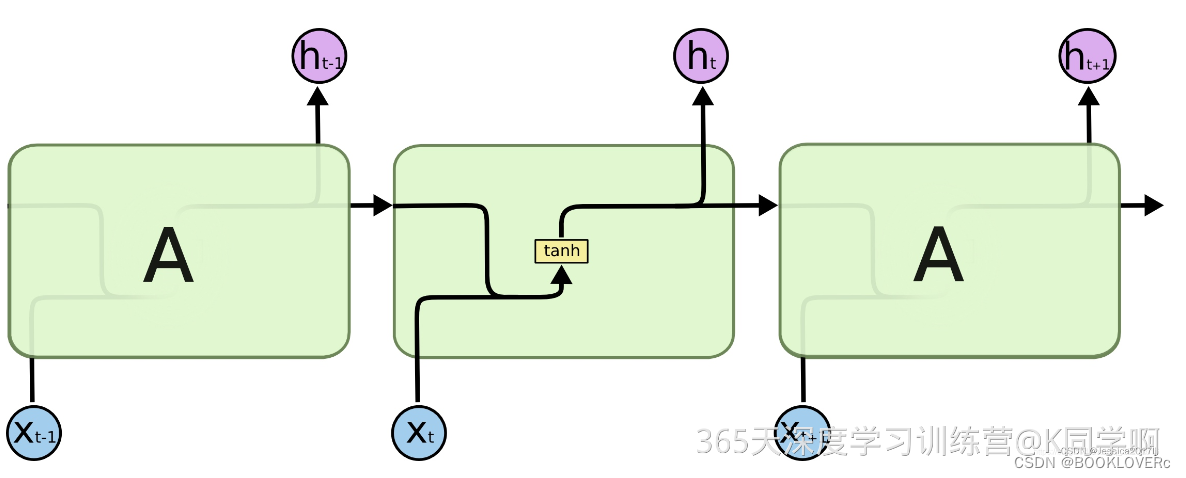
LSTM避免了长期依赖的问题。可以记住长期信息!LSTM内部有较为复杂的结构。能通过门控状态来选择调整传输的信息,记住需要长时间记忆的信息,忘记不重要的信息,其结构如下:
2.数据准备
import numpy as np
import pandas as pd
import torch
from torch import nn
import torch.nn.functional as F
from torch.utils.data import TensorDataset, DataLoader
data = pd.read_csv("./dataRnn2/woodpine2.csv")
print(data.head(5))
print(data.columns)
Time Tem1 CO 1 Soot 1
0 0.000 25.0 0.0 0.0
1 0.228 25.0 0.0 0.0
2 0.456 25.0 0.0 0.0
3 0.685 25.0 0.0 0.0
4 0.913 25.0 0.0 0.0
Index(['Time', 'Tem1', 'CO 1', 'Soot 1'], dtype='object')输出前五列
import matplotlib.pyplot as plt
import seaborn as sns
plt.rcParams['savefig.dpi'] = 500 #图片像素
plt.rcParams['figure.dpi'] = 500 #分辨率
fig, ax =plt.subplots(1,3,constrained_layout=True, figsize=(14, 3))
sns.lineplot(data=data["Tem1"], ax=ax[0])
sns.lineplot(data=data["CO 1"], ax=ax[1])
sns.lineplot(data=data["Soot 1"], ax=ax[2])
plt.show()

数据集原始数据随时间变化情况
dataFrame = data.iloc[:,1:]
dataFrame
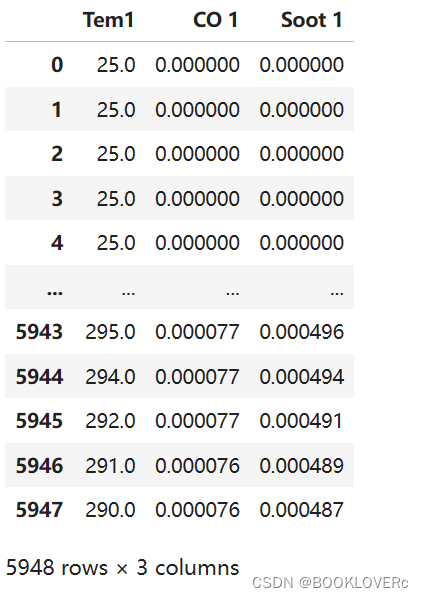
dataFrame = data.iloc[:,1:].copy()
## 归一化
from sklearn.preprocessing import MinMaxScaler
col=[ 'CO 1', 'Soot 1', 'Tem1']
#将数据归一化,范围是0到1
sc = MinMaxScaler(feature_range=(0, 1))
for i in col:
dataFrame[i] = sc.fit_transform(dataFrame[i].values.reshape(-1, 1))
print(dataFrame.shape)
###设置X、y
width_X = 8
width_y = 2
##取前8个时间段的Tem1、CO 1、Soot 1为X,第9个时间段的Tem1为y。
X = []
y = []
in_start = 0
for _, _ in data.iterrows():
in_end = in_start + width_X
out_end = in_end + width_y
if out_end < len(dataFrame):
X_ = np.array(dataFrame.iloc[in_start:in_end , ])
#X_ = X_.reshape((len(X_)*3))
y_ = np.array(dataFrame.iloc[in_end :out_end, 0])
X.append(X_)
y.append(y_)
in_start += 1
X = np.array(X)
y = np.array(y).reshape(-1,1,2)
X.shape, y.shape-
首先,通过
data.iloc[:,1:].copy()选择了数据中除第一列外的所有列,将其存储在dataFrame变量中。这里使用.copy()方法是为了确保生成一个新的数据框,而不是对原始数据进行修改。 -
接着,通过
MinMaxScaler对选定的列进行了归一化处理,这些列是 'CO 1', 'Soot 1', 'Tem1'。归一化的范围被限制在 0 到 1 之间。 -
然后,设置了输入和输出的宽度,分别为
width_X = 8和width_y = 2。 -
通过循环遍历数据中的每一行,并以每行数据的前8个时间段的 'CO 1', 'Soot 1', 'Tem1' 作为输入
X,第9个时间段的 'Tem1' 作为输出y。这里通过移动窗口的方式来获取输入和输出数据。 -
在循环过程中,根据输入和输出的宽度以及当前的起始位置,从
dataFrame中选择对应的数据,并将其加入到X和y中。其中,X是一个三维数组,y是一个二维数组。 -
最后,将
X和y转换为 NumPy 数组,并输出它们的形状。
print(np.any(np.isnan(X)))
print(np.any(np.isnan(y)))
检查数据集中是否有空值
X_train = torch.tensor(np.array(X[:5000]), dtype=torch.float32)
y_train = torch.tensor(np.array(y[:5000]), dtype=torch.float32)
X_test = torch.tensor(np.array(X[5000:]), dtype=torch.float32)
y_test = torch.tensor(np.array(y[5000:]), dtype=torch.float32)
X_train.shape
取5000之前的数据为训练集,5000之后的为验证集
train_dl = DataLoader(TensorDataset(X_train, y_train),batch_size=64, shuffle=False)
test_dl = DataLoader(TensorDataset(X_test, y_test),batch_size=64, shuffle=False)
3.模型构建
*LSTM **
LSTM接收数据形式为input_size=(batce_size,seq_length,input_size)此处input_size=out_channels,将维度交换有:
input_size=(batch_size,seq_length,out_channels)
LSTM输出结果维度形式为:
output=(batch_size, seq_len, num_directions * hidden_size)
全连接层的输入维度形式为:
fc=(hidden_size,output_size)
LSTM隐层状态h0, c0通常初始化为0,大部分情况下模型也能工作的很好。
LSTM的隐藏层初始状态h0, c0可以看做是模型的一部分参数,并在迭代中更新
class model_lstm(nn.Module):
def __init__(self):
super(model_lstm, self).__init__()
self.lstm0 = nn.LSTM(input_size=3 ,hidden_size=320, num_layers=1, batch_first=True)
self.lstm1 = nn.LSTM(input_size=320 ,hidden_size=320, num_layers=1, batch_first=True)
self.fc0 = nn.Sequential(nn.Linear(320, 300),nn.Dropout(0.3))
self.fc1 = nn.Sequential(nn.Linear(300, 2))
def forward(self, x):
#h_0 = torch.randn(1, x.size(0), 64) #num_layers * num_directions(单向/双向), bs,hidden_size
#c_0 = torch.randn(1, x.size(0), 64) #num_layers * num_directions(单向/双向), bs,hidden_size
#如果不传入h0和c0,pytorch会将其初始化为0
out, hidden1 = self.lstm0(x)
out, _ = self.lstm1(out, hidden1)
out = self.fc0(out)
out = self.fc1(out)
return out[:, -1:, :] #取2个预测值,否则经过lstm会得到8*2个预测
'''
def init_weight(model):
for m in model.modules():
if isinstance(m, nn.Linear):
torch.nn.init.uniform_(m.weight.data, a=0, b=1)
'''
model = model_lstm()
#model.apply(init_weight)
model
4.模型训练
#设置GPU训练
device=torch.device("cuda" if torch.cuda.is_available() else "cpu")
# 训练循环
import copy
def train(train_dl, model, loss_fn, opt, lr_scheduler=None):
size = len(train_dl.dataset)
num_batches = len(train_dl)
train_loss = 0 # 初始化训练损失和正确率
for x, y in train_dl:
x, y = x.to(device), y.to(device)
# 计算预测误差
#pred = model(x)
pred = model(x) # 网络输出
loss = loss_fn(pred, y) # 计算网络输出和真实值之间的差距
# 反向传播
opt.zero_grad() # grad属性归零
loss.backward() # 反向传播
opt.step() # 每一步自动更新
# 记录loss
train_loss += loss.item()
if lr_scheduler is not None:
lr_scheduler.step()
print("learning rate = ", opt.param_groups[0]['lr'])
train_loss /= num_batches
return train_loss
def test (dataloader, model, loss_fn):
size = len(dataloader.dataset) # 测试集的大小
num_batches = len(dataloader) # 批次数目
test_loss = 0
# 当不进行训练时,停止梯度更新,节省计算内存消耗
with torch.no_grad():
for x, y in dataloader:
x, y = x.to(device), y.to(device)
# 计算loss
y_pred = model(x)
loss = loss_fn(y_pred, y)
test_loss += loss.item()
test_loss /= num_batches
return test_loss
#训练模型
model = model_lstm()
model = model.to(device)
loss_fn = nn.MSELoss() # 创建损失函数
learn_rate = 1e-1 # 学习率
opt = torch.optim.SGD(model.parameters(),lr=learn_rate,weight_decay=1e-4)
epochs = 150
train_loss = []
test_loss = []
lr_scheduler = torch.optim.lr_scheduler.CosineAnnealingLR(opt,epochs, last_epoch=-1)
best_val =[0, 1e5]
for epoch in range(epochs):
model.train()
epoch_train_loss = train(train_dl, model, loss_fn, opt, lr_scheduler)
model.eval()
epoch_test_loss = test(test_dl, model, loss_fn)
if best_val[1] > epoch_test_loss:
best_val =[epoch, epoch_test_loss]
best_model_wst = copy.deepcopy(model.state_dict())
train_loss.append(epoch_train_loss)
test_loss.append(epoch_test_loss)
template = ('Epoch:{:2d}, Train_loss:{:.6f}, Test_loss:{:.6f}')
print(template.format(epoch+1, epoch_train_loss, epoch_test_loss))
print("*"*20, 'Done', "*"*20)
print("best_train= ", best_train)
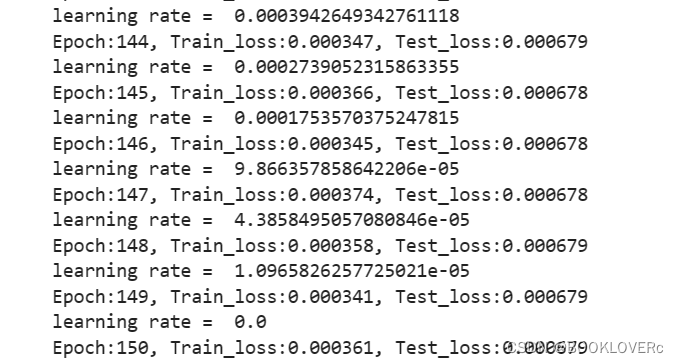
5.模型评估
#LOSS图
# 支持中文
import matplotlib.pyplot as plt
plt.rcParams['font.sans-serif'] = ['SimHei'] # 用来正常显示中文标签
plt.rcParams['axes.unicode_minus'] = False # 用来正常显示负号
plt.figure(figsize=(5, 3),dpi=120)
plt.plot(train_loss , label='LSTM Training Loss')
plt.plot(test_loss, label='LSTM Validation Loss')
plt.title('Training and Validation Loss')
plt.legend()
plt.show()
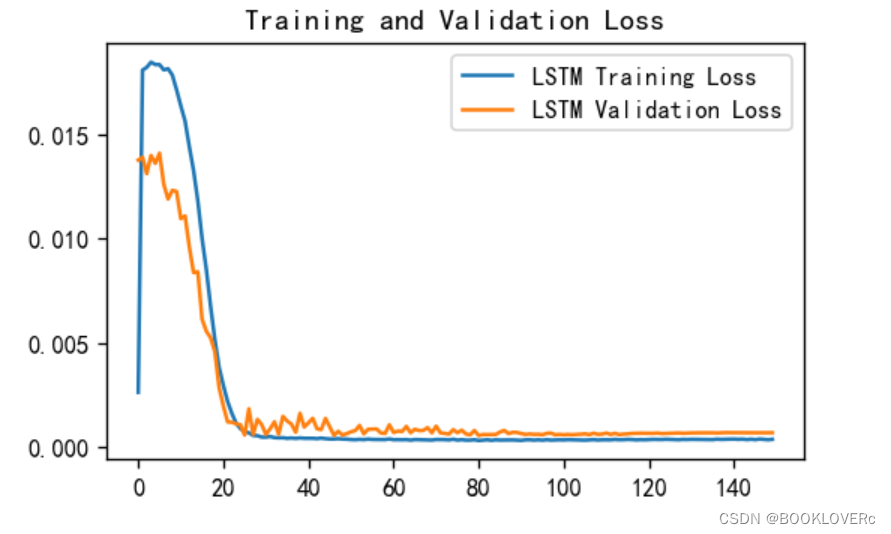
预测
model.load_state_dict(best_model_wst)
model.to("cpu")
predicted_y_lstm = sc.inverse_transform(model(X_test).detach().numpy().reshape(-1,1)) # 测试集输入模型进行预测
y_test_1 = sc.inverse_transform(y_test.reshape(-1,1))
y_test_one = [i[0] for i in y_test_1]
predicted_y_lstm_one = [i[0] for i in predicted_y_lstm]
plt.figure(figsize=(5, 3),dpi=120)
# 画出真实数据和预测数据的对比曲线
plt.plot(y_test_one[:2000], color='red', label='real_temp')
plt.plot(predicted_y_lstm_one[:2000], color='blue', label='prediction')
plt.title('Title')
plt.xlabel('X')
plt.ylabel('Y')
plt.legend()
plt.show()
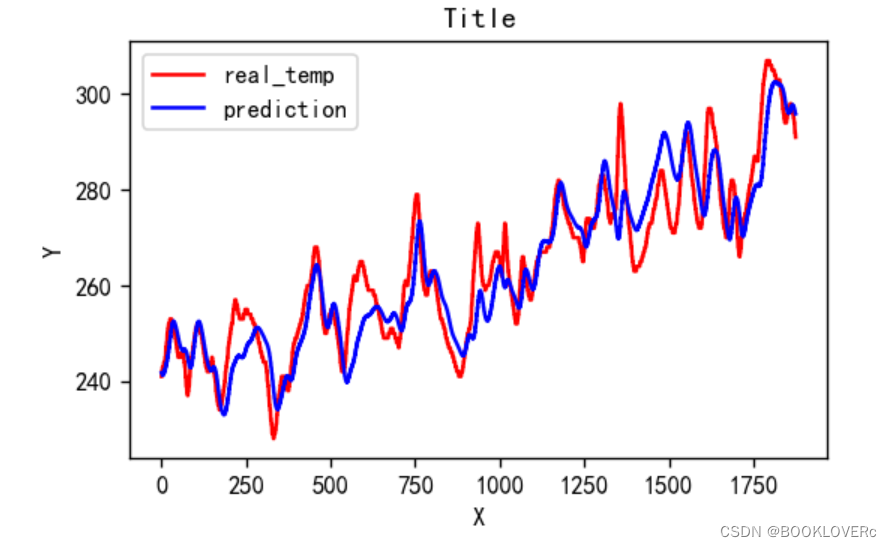
from sklearn import metrics
"""
RMSE :均方根误差 -----> 对均方误差开方
R2 :决定系数,可以简单理解为反映模型拟合优度的重要的统计量
"""
RMSE_lstm = metrics.mean_squared_error(predicted_y_lstm_one, y_test_1)**0.5
R2_lstm = metrics.r2_score(predicted_y_lstm_one, y_test_1)
print('均方根误差: %.5f' % RMSE_lstm)
print('R2: %.5f' % R2_lstm)

test_1 = torch.tensor(dataFrame.iloc[:8 , ].values,dtype = torch.float32).reshape(1,-1,3)
pred_ = model(test_1)
pred_ = np.round(sc.inverse_transform(pred_.detach().numpy().reshape(1,-1)).reshape(-1),2)
real_tem = data.Tem1.iloc[:2].values
print(f"第9~10时刻的温度预测:", pred_)
print("第9~10时刻的真实温度:", real_tem)








 本文介绍了如何使用LSTM在365天深度学习训练营中进行时间序列数据的处理,包括数据预处理、模型构建(使用LSTM和全连接层)、训练过程以及模型评估(RMSE和R2分数)。作者展示了如何用LSTM预测时间序列数据,并展示了预测结果与真实值的比较。
本文介绍了如何使用LSTM在365天深度学习训练营中进行时间序列数据的处理,包括数据预处理、模型构建(使用LSTM和全连接层)、训练过程以及模型评估(RMSE和R2分数)。作者展示了如何用LSTM预测时间序列数据,并展示了预测结果与真实值的比较。














 414
414











 被折叠的 条评论
为什么被折叠?
被折叠的 条评论
为什么被折叠?








